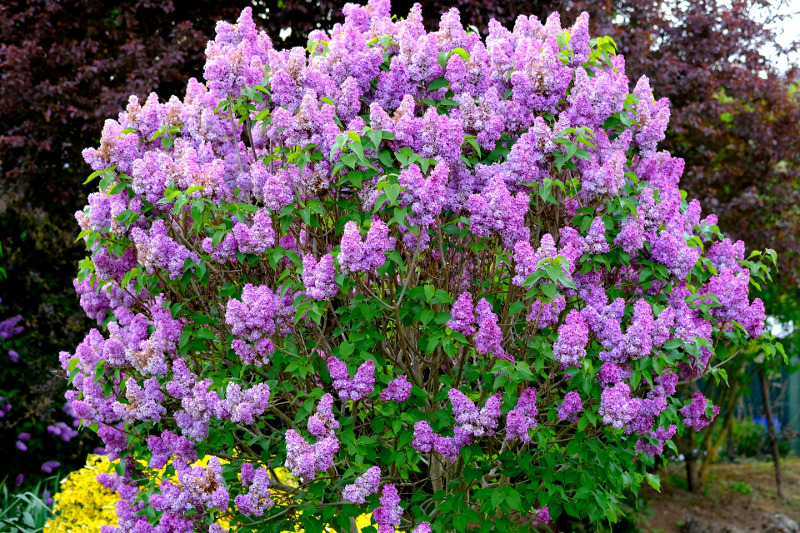Lilacs are native to Europe and the more temperate parts of Asia, in the family Syringa. Most garden lilacs are varieties of Syringa vulgaris.
Hardiness is usually USDA zones 3-8, although there are a couple of outliers in 2 and 9. The majority prefer some winter chilling and dislike intense heat and humidity. These old-fashioned favorites are low-maintenance, long-lived and offer transporting fragrance on an upright, deciduous, multi-stemmed shrub. Typically S. vulgaris are up to ten feet tall, and once-blooming in April/May, but there are newer varieties and hybrids that are dwarf and/or rebloom. Japanese Tree Lilacs, S. reticulata, can grow up to 30 feet tall.

Planting Lilacs
Fall and early spring are ideal planting times. Choose a well-drained spot with at least six hours of sun daily, spaced well to allow air circulation. Avoid planting in lawns as they can be too wet, and the fertilizer is not compatible. The hole should be the plant’s current depth, but twice as wide. Mulch a two-three foot circle around the lilac without burying the stem to discourage borers or burying a graft, if there is one.
Watering Lilacs
Water the soil rather than the leaves to keep powdery mildew at bay. Irrigation or careful hand watering the soil will be better than sprinklers. Water deeply to foster strong root growth – at least once weekly, more during dry or very hot weather. An inch per week is a good start. Thirst shows up as distorted or wilted leaves.

Fertilizing Lilacs
Lilacs prefer rich soil, so annual applications of compost are welcome. However, they do not like too much fertilizer, especially nitrogen-rich ones which boosts leaf growth at the expense of flowers. Look for a balanced fertilizer of perhaps 10-10-10 and apply sparingly in late winter.
Pruning Lilacs
The best time to prune is immediately after flowering. Buds for next year set very quickly, so pruning anytime later will sacrifice a season of bloom. Deadhead all spent blooms. Remove the oldest stems to the ground (but not more than 1/3 of the shrub), as well as any weak, crossing, or crowded stems. Crowding can encourage powdery mildew. Any suckers from grafted lilacs should be removed.
To rejuvenate an older lilac, you can go as far as pruning a lilac down to eight inches, but you may see reduced flowering for a year or two.

Caring For Lilacs in Pots
Choose a dwarf variety like S. pubescens ‘Miss Kim,’ and plant in well-draining potting soil with generous width in the pot for root growth. Mulch to conserve moisture, but keep away from the stem. Avoid fertilizer until the plant’s second winter. Water deeply, at least three times a week while getting established, more during hot or dry weather.
Winter Care for Lilacs
Lilacs are very winter hardy as a rule, so no special protection is needed. In fall clean up any old, especially diseased foliage and top-dressing with compost. A light amount of balanced 10-10-10 fertilizer in late winter will promote strong growth. Do not prune in winter, because since they mainly bloom on old wood, you’ll be pruning off the year’s blooms. The best time to prune is right after bloom in spring before new buds are set.

Best Selling Lilacs
Common Lilac Care Questions
Can You “Force” Lilacs?
Lilac branches can be forced a few weeks early, indoors, but mocking typical spring weather conditions indoors. Emulating spring moisture and temperature fluctuations can trick them into breaking out of their natural winter dormancy.
Do Lilacs Spread?
Some lilac varieties do send runners from their roots, thus making propagation very easy! Their roots are generally very shallow and they can increase the size of your shrub up to one and half times.
How Big Do Lilac Bushes Get?
Lilacs vary in size greatly, depending on the variety. There are some dwarf bushes that may only reach 4 to 5 feet high and as little as 3 to 7 feet wide and larger lilacs that may get up to 15 feet tall by 12 feet wide.
What Is The Growth Rate For Lilac?
Most lilacs have a relatively moderate growth rate, gaining 1 to 2 feet yearly.
When Do Lilacs Bloom?
The old varieties of lilacs bloom for a couple of weeks in mid- to late- spring but there are now many varieties that bloom both earlier, and later, in the season. When they're planted together, you can have lilac blooms for many weeks!
Why Are My Lilacs Wilting?
Too much water can result in wilted, pale, or yellowing leaves. Established shrubs can tolerate short periods of drought-like conditions without damage. Longer periods of dry conditions can cause the leaves and the stems of the lilac to wilt.
How Long Do Lilac Flowers Last?
Blooms last for about about 2 weeks from mid-to-late spring.
How Do You Keep Lilacs Blooming?
Removing the dead flowers from your lilac bush will encourage more blooms the following year. Ensuring that they get sufficient amounts of sunlight also will help in the blooming season.
Are Lilacs Acid Loving?
Lilac plants do not like acidic soil. They grow best in alkaline, moist well-drained soil.
How Do You Make Lilacs Grow Faster?
Lilacs grow faster when they receive enough sunlight and when it's planted in good soil. Feeding them in the spring can help to give them a boost as well.
Why Do Lilac Leaves Turn Brown?
Lilac leaves may turn brown if exposed to too much sun. This can happen if the plant is grown in a sunny location or if the leaves are exposed to direct sunlight for extended periods.
Have a question about Lilac? Fill out the form below and we will try and get back to your question as soon as possible. We may even feature your question on this article to help other gardeners!
 |
Author Erica Browne Grivas - Published 06-04-2021 |
